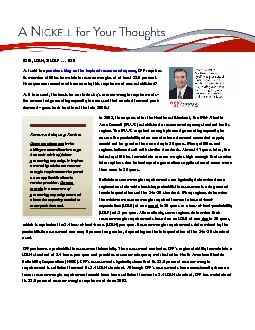

SPP requires memberutilitiesto maintain reserve margins of at least 136 percent Have you ever wondered how or why this requirementwas established As it turns out the basis forour industry146 ID: 831559
Download Pdf The PPT/PDF document "LOLE, LOLH, & LOLP . . . LOL!As I said i..." is the property of its rightful owner. Permission is granted to download and print the materials on this web site for personal, non-commercial use only, and to display it on your personal computer provided you do not modify the materials and that you retain all copyright notices contained in the materials. By downloading content from our website, you accept the terms of this agreement.
LOLE, LOLH, & LOLP . . . LOL!As I said i
LOLE, LOLH, & LOLP . . . LOL!As I said in previous blog on the topic of resource adequacy, SPP requiresmemberutilitiesto maintain reserve margins of at least 13.6 percent. Have you ever wondered how or why this requirementwas established? As it turns out, the basis forour industry’sreserve(LOLP) of .1 per year.Alternatively, some regionsdetermine their reservemargin requirements based on an LOLE of one dayin yearswhich is equivalent to 2.4 lossofloadhours (LOLH) peryear.eservemargin requremets determined by the probabilistic assessment SPP performs a probabilistic assessment bienniallyThe assessment evaluateSPP’s regional ability to maintain a LOLH standard of 2.4 hours per year and provideresourceadequacy metrics to the North American ElectricReliability Corporation (NERC) Resource Adequacy ReviewResource adequacyis the ability to meet electricusage demands with sufficient generating capacity. It is often assured by minimum reservemargin requirements imposed on an applicable electric service provider. Reserve marginis a measure of generating capacity over and above the capacity needed to meet peak demand. Like SPP, most regions develop a specific requirement, but some simply establish a target, using it for reporting purposes only. Some regions assessand update their requirements annuallywhile others assesstheir requirements regularly but seldom change them. NERC does not manda
te the standard or a consistent interpre
te the standard or a consistent interpretation, nor does itmandate a specificreservemargin requirement. NERC does recommend a reference level of 15 percent in the event that a region has not established a requirement for its utilities. As shown below, eservemargin requirements across North America generally vary between 10 and 20 percent, a resultof regional differences in electric system characteristics and in the application of resourceadequacy standardsA number of papers have been written over the last severalyears questioningthe standard’s validity and the economic prudence of applying it to derive reservemargin requirements. Despite the standardwideusein the industry, there is little historical record of its reliability value for resource adequacy. SPP’s newly formed Capacity Margin Task Force will need to consider the appropriateness of continued usage of this standardin the SPP region. It will not be a simple task. How much reliability is assuredby maintaining reserve margins to meet a standard? Is that amount of reliability worth the cost? Can we reduce reserve margins to meet a lower standard and still maintain a reasonable and affordable level of reliability? I look forward to addressing these and other similar questions withthe Capacity Margin Task Forcein the near futureStay tuned!Read more from Lannyon our website. Questions and comments can be emailed to communication@spp.org.